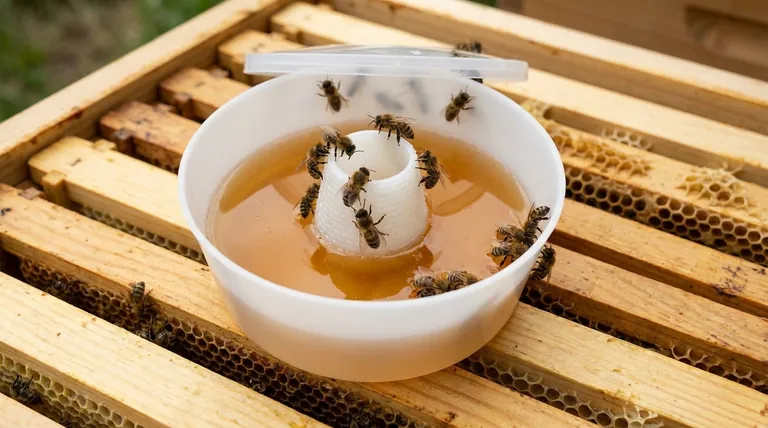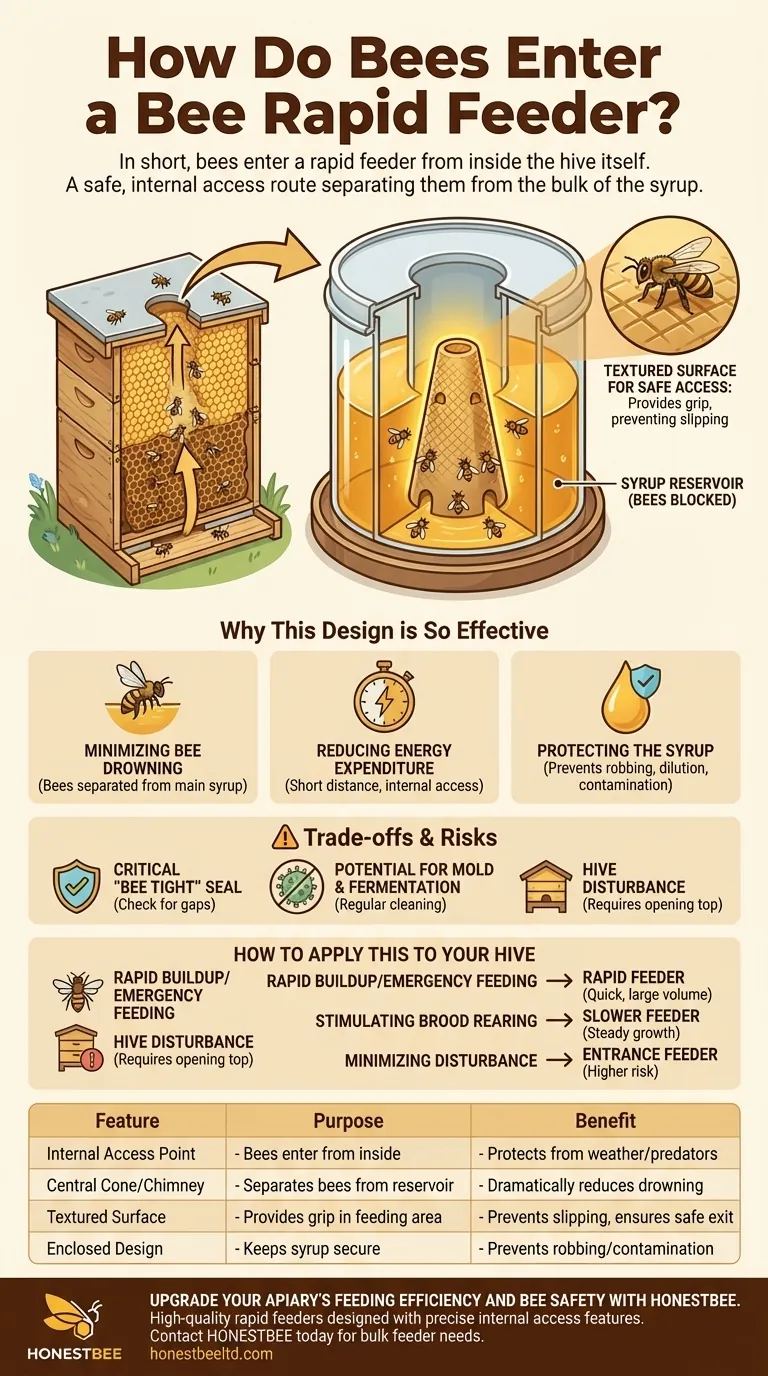In short, bees enter a rapid feeder from inside the hive itself. They crawl up through an opening in the hive's inner cover into a protected access point, typically a central cone or chimney within the feeder. This design allows them to reach the syrup without having to enter the main reservoir, dramatically reducing the risk of drowning.
A bee rapid feeder is engineered with a core principle: separate the bees from the bulk of the syrup. Its design provides a safe, internal access route that minimizes bee casualties while allowing for the quick delivery of a large volume of food.

The Mechanics of a Rapid Feeder
A rapid feeder, also known as a top feeder, is an internal hive-top feeder. Its design is a direct solution to the drowning problems common with simpler, open feeding methods.
The Central Access Point
The feeder is placed directly on top of the uppermost hive box, replacing the hive's standard inner cover. Bees travel up from the brood nest through the central hole in the hive body.
This internal access means the bees do not have to leave the hive to feed. This conserves their energy and protects them from poor weather or predators.
The Protective Cone or Chimney
At the center of the feeder is a cone, cup, or screened-off channel. This "chimney" is the only place bees can enter the feeder. It allows them to access the syrup that fills the outer channel around it.
This barrier is the most critical safety feature, as it prevents bees from gaining access to the main reservoir where they could easily drown.
The Textured Surface for Safe Access
The inner surfaces of the access cone and feeding area are intentionally textured or scored. This provides a rough surface that bees can easily grip with their feet.
This secure footing ensures that even if a bee gets covered in sticky syrup, it can climb out and return to the cluster below without slipping and drowning.
Why This Design is So Effective
The rapid feeder's design isn't just about delivering food; it's about doing so in the safest and most efficient way for the colony.
Minimizing Bee Drowning
Drowning is a major risk with many types of feeders. By keeping the bees contained in a small access area separate from the large volume of syrup, the rapid feeder dramatically reduces bee losses.
Reducing Energy Expenditure
Because the food source is located directly above their cluster, bees expend minimal energy to access it. They do not need to fly or navigate long distances, which is especially beneficial for new, weak, or overwintering colonies.
Protecting the Syrup
An enclosed top feeder protects the sugar syrup from being stolen by bees from other hives (robbing) or by wasps. It also prevents rainwater from diluting the feed and keeps debris from contaminating it.
Understanding the Trade-offs and Risks
While highly effective, rapid feeders require proper setup and management to avoid potential problems.
The Critical 'Bee Tight' Seal
The single greatest risk is a faulty seal on the access cone. If the cone or hardware cloth is loose, bees can squeeze through the gaps and get into the main syrup reservoir. This can lead to the mass drowning of hundreds or thousands of bees.
Before every use, you must ensure the access point is completely "bee tight" and that there are no gaps for bees to crawl through.
Potential for Mold and Fermentation
Like any container of sugar water, a rapid feeder can develop mold or begin to ferment if left too long. It is crucial to check the feeder regularly and clean it thoroughly between refills.
Hive Disturbance
Refilling a rapid feeder requires you to open the top of the hive. While quick, this does cause a minor disturbance to the colony. You must place an empty hive box around the feeder to create space for it and to provide a surface for the outer cover.
How to Apply This to Your Hive
Choosing to use a rapid feeder depends entirely on your colony's needs and your management goals.
- If your primary focus is emergency feeding or rapid buildup: The rapid feeder is the best tool for delivering a large quantity of food quickly and safely to a weak hive or during a nectar dearth.
- If your primary focus is stimulating brood rearing: A slower feeding method, like a frame feeder or Boardman feeder, might be preferable to encourage steady population growth rather than rapid storage.
- If your primary focus is minimizing hive disturbance: An entrance feeder can be refilled without opening the hive, but it carries a much higher risk of attracting robbers and must be managed carefully.
By understanding how a rapid feeder is designed to protect your bees, you can use this tool to effectively support your colony's health and growth.
Summary Table:
| Feature | Purpose | Benefit |
|---|---|---|
| Internal Access Point | Allows bees to enter from inside the hive | Protects bees from weather and predators |
| Central Cone/Chimney | Separates bees from the main syrup reservoir | Dramatically reduces drowning risk |
| Textured Surface | Provides grip for bees in the feeding area | Prevents slipping and ensures safe exit |
| Enclosed Design | Keeps syrup secure within the hive | Prevents robbing and contamination |
Upgrade your apiary's feeding efficiency and bee safety with HONESTBEE.
As a trusted supplier for commercial apiaries and beekeeping equipment distributors, we provide high-quality rapid feeders designed with the precise internal access features detailed above. Our wholesale-focused operations ensure you get durable, bee-tight equipment that supports colony health and maximizes productivity.
Contact HONESTBEE today to discuss your bulk feeder needs and discover how our solutions can benefit your operation.
Visual Guide

Related Products
- Rapid Bee Feeder White Plastic 2L Round Top Feeder for 8 or 10-Frame Bee Hives
- Professional Hive Front Entrance Bee Feeder
- HONESTBEE Entrance Bee Feeder Professional Hive Nutrition Solution for Beekeeping
- Professional Hive Top Bee Feeder for Beekeeping
- In-Hive Dual Compartment Frame Bee Feeder for Targeted Colony Nutrition
People Also Ask
- How do you set up and use a top feeder for bees? A Step-by-Step Guide for Safe Feeding
- Can sugar syrup contaminate the honey crop? A Beekeeper's Guide to Protecting Honey Purity
- What is the best thing to feed bees? A Guide to Supplemental Feeding for a Thriving Hive
- What can the round hive top feeder be used for? A Guide to Efficient, Safe Bee Feeding
- What is the capacity of the round hive top feeder for syrup and pollen? A Guide to Targeted Apiary Support



















